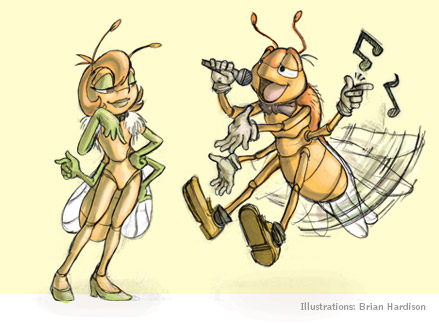


by Judy Purdy

![]()
![]()

It’s easy to tell when a male fruit fly has mating on his mind. He performs a distinctive ritual that contains characteristic steps, said Yong-Kyu Kim.
Kim, a University of Georgia behavioral geneticist, has for two decades been studying courtship behaviors among six closely related fruit-fly species. Depending on the species, he said, a courting male will try some combination of the following moves:
• Approach a female and orient toward her.
• Tap on her abdomen using his forelegs.
• Circle around her while she stands still.
• Scissor his wings — opening and closing them — in front of her.
• Vibrate his wings to “sing” a courtship song.
• Extend his proboscis and lick her genitalia.
An uninterested female may run away. Or she might twist her body and extrude her ovipositor — a tubular appendage for laying eggs — in the male’s face as if to say, “Bug off!” She may even resort to kicking. But a female in the mood stands still and opens her wings to signal her interest.
Each of the six “sibling” species that Kim studies has its own distinctive courtship rituals, songs and pheromones — chemical secretions, including sexual “perfumes,” that elicit behavioral or physiological responses in other animals. “Each fruit-fly species expresses its own unique smells that attract the opposite sex and influence courtship behaviors,” he said.
Kim is using such differences to study mate selection behaviors among closely related species. By isolating some larvae as soon as they hatch — raising them with no contact of any kind with parents, siblings or other flies — he has shown that as adults their communication signals get scrambled. In other words, early socialization affects ultimate mating behavior and success.

“Important learning goes on during the larval stage, when individuals learn to recognize and differentiate their own species from sister species,” Kim said. “They learn olfactory signals —the smell of their species — and they use olfactory memory in mate selection. With increased amounts of communication, flies are more likely to choose mates of the same species.”
By contrast, flies that were isolated during development could not readily distinguish between their own species and closely related ones, Kim said. While isolated males displayed courtship behaviors more frequently, they had little regard for the gender or species of their courting advances. “Socially isolated flies had no chance to learn,” he said.
Kim has in fact discovered neurological differences between fruit flies raised in groups and in isolation. The section of the brain called the “mushroom body,” which plays a part in olfactory learning and information processing, is smaller in the flies that had been socially isolated.
A fly’s inability to discriminate can have consequences for its reproductive success. When socially isolated flies got to choose between a partner of the same or of a different species, they were more likely to mate with the latter. But their young would be sterile hybrids, Kim said. “Essentially, those matings are reproductively erased.”
Bottom line, Kim said, is that while “all fruit-fly behavior is primarily controlled by genes, it can be modified by experience.”
For comments or for information please e-mail the editor: jbp@ovpr.uga.edu
To contact the webmaster please email: ovprweb@uga.edu
![]()